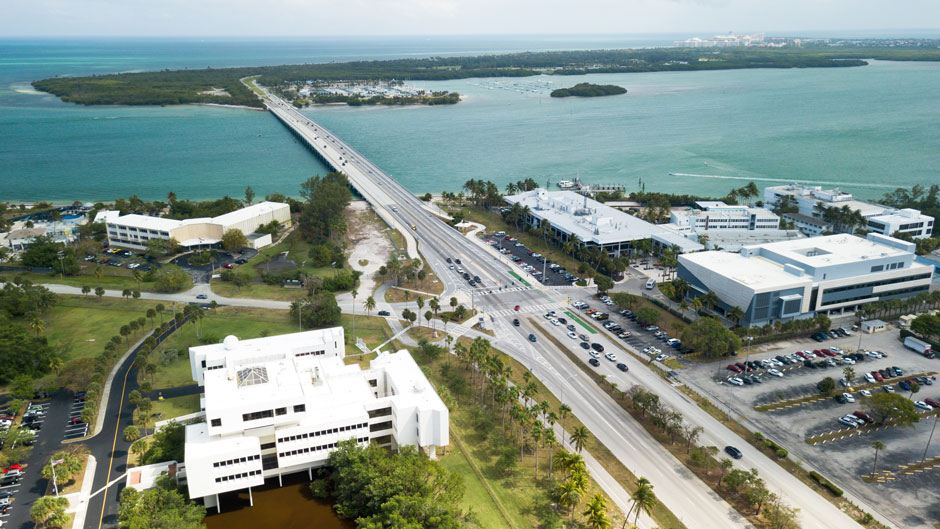Typically, it is the approach of a tropical cyclone that sends University of Miami emergency management officials into alert mode. But this was something different—something they had never experienced in their collective memory.
Red tide, which has decimated Florida’s Gulf Coast for nearly a year, killing marine life and causing respiratory ailments in residents and visitors, had been detected in the waters off Miami-Dade’s shoreline for what many believed was the first time ever.
While contamination levels were low, county officials still took precautionary measures, closing public beaches north of Haulover Inlet for a day in early October. Since then, tests have shown that the toxic algae have dissipated off most of Miami-Dade’s shorelines.
But what if the condition had worsened? How would a more severe outbreak of red tide have affected UM’s Rosenstiel School of Marine and Atmospheric Science on Virginia Key, where local seawater is used extensively in research programs and experiments? And what preventive measures would have needed to be taken?
A recent meeting between UM’s Office of Emergency Management, Rosenstiel School officials and researchers, and the Village of Key Biscayne sought to answer those questions.
“The goal was to identify our vulnerabilities and get key partners engaged early and operating on the same sheet of music so that if the problem worsened, we’d already be in position to better address it in terms of how we’re communicating, sharing information, and making decisions,” Matthew Shpiner, UM’s director of emergency management, said of the meeting that took place on Key Biscayne immediately after red tide was discovered in Miami waters.
At the gathering, officials discussed plans to address the red tide threat, and Rosenstiel School researchers were on hand to answer questions about the harmful algal bloom and how it affects people and marine life.
“People pay attention to red tide when the levels reach a point that it affects people’s health or that it kills fish,” said Mike Schmale, a professor of marine biology and ecology and associate dean for infrastructure at the Rosenstiel School. “But our research operations and laboratories rely on running seawater that’s taken in from the nearby ocean environment. And even low levels of contamination could be extremely harmful to that marine life.”
Schmale, who studies diseases in marine organisms, noted that the school is home to a National Institutes of Health-funded Aplysia lab—the only place in the world where California sea hares are cultured and raised for research and teaching—as well as other labs where investigators study fish, corals, and other invertebrates that are vulnerable to red tide.
“If the red tide had reached anywhere near the level that is typically noted by the news outlets, we would run the risk of losing all those animals,” said Schmale, who attended the meeting.
As such, the Rosenstiel School has a plan in place to protect its research specimens from red tide-contaminated seawater. It includes using alternative water sources and re-circulating seawater with a filtration system, according to John Gulla, emergency management coordinator at the Rosenstiel School.
For now, the threat to beaches in Miami has waned, but UM officials are still being vigilant, keeping an eye of the situation and even testing the waters themselves for the presence of the harmful algal bloom.
“There’s still a lot more work to do,” said Schmale. “But we’ve started implementing emergency measures and putting them on standby. We’ve also started measuring red tide levels ourselves in our immediate area, in addition to receiving test results from state agencies.”
Shpiner, Gulla, Schmale and Key Biscayne officials all called the meeting “extremely useful” and noted that other such summits will occur in the future. Key Biscayne is even exploring the possibility of funding a beach contamination study that would be led by College of Engineering professor Helena Solo-Gabriele.
“The Village of Key Biscayne is excited to collaborate with the Rosenstiel School in an effort to work with scientists to design a testing program that we hope will lead to an understanding of the most recent water quality issues the region has been experiencing, including red tide. As a coastal community, we want to know what the root causes are and what we can do to reduce any manmade impacts on our most precious coastline,” said Key Biscayne Village Manager Andrea Agha.
“We’re trying to make these stakeholder meetings happen more frequently, so that we’re not just getting in touch with each other during a crisis,” said Gulla. “Red tide is a major concern for us in our area right now, but there are certainly other issues that affect us both equally. There’s only one road in and one road out of the RSMAS campus and Key Biscayne. We have that in common, so it helps us to continually stay engaged.”

